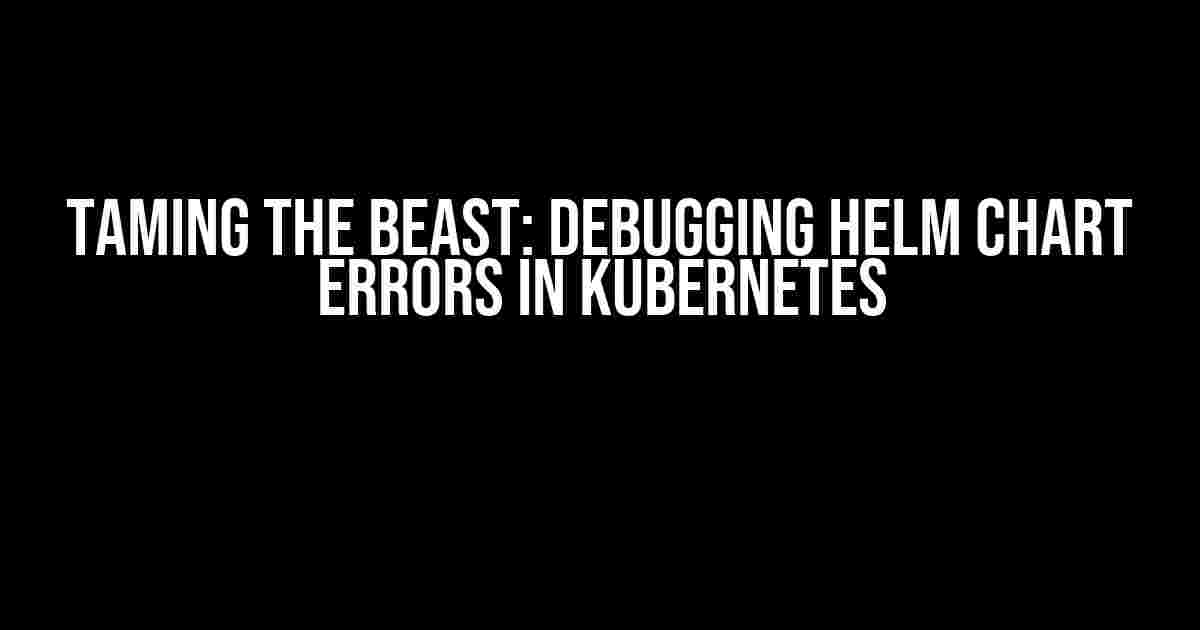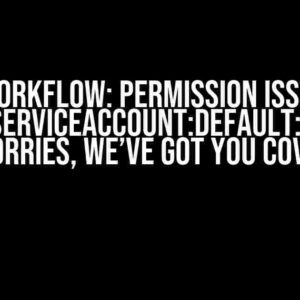Are you stuck in the never-ending loop of frustration, trying to deploy a project in Kubernetes using Helm, only to be met with an error at line 49? You’re not alone! Many developers have walked this path, and I’m here to guide you through the troubleshooting process. Buckle up, and let’s dive into the world of Helm chart debugging!
Understanding the Error
Before we dive into the troubleshooting process, it’s essential to understand the error message. The error at line 49 could be related to various aspects of your Helm chart, such as:
- Syntax errors in the YAML or JSON files
- Incorrect configuration or values
- Dependency issues or version conflicts
- Kubernetes cluster configuration problems
Take a deep breath, and let’s break down the error message. Identify the specific error code, message, and any relevant information provided. This will help us narrow down the possible causes and create a plan of attack.
Step 1: Review the Helm Chart Structure
A well-structured Helm chart is crucial for a successful deployment. Verify that your chart adheres to the Helm chart structure guidelines:
my-chart/
Chart.yaml
values.yaml
templates/
deployment.yaml
service.yaml
...
charts/
dependency-chart/
Chart.yaml
values.yaml
...
Ensure that:
- The Chart.yaml file contains the required metadata, such as name, version, and description.
- The values.yaml file is correctly formatted and contains the required values for your chart.
- The templates/ directory contains the correct template files for your resources, such as deployment.yaml and service.yaml.
- The charts/ directory contains any dependent charts, with correct Chart.yaml and values.yaml files.
Step 2: Validate YAML and JSON Files
Syntax errors in YAML or JSON files can cause the Helm chart to fail. Validate your files using tools like:
helm lint my-chart helm template my-chart --debug
This will help identify any syntax errors or inconsistencies in your files.
Step 3: Check Helm Version and Configuration
Ensure you’re running the latest version of Helm, and verify that your Helm configuration is correct:
helm version helm env
This will display the Helm version and configuration information. Compare your version with the latest release to ensure you’re up-to-date.
Step 4: Inspect the Kubernetes Cluster
Kubernetes cluster issues can also cause Helm chart errors. Verify that:
- Kubernetes is running correctly, and the cluster is healthy.
- The cluster has sufficient resources and capacity for your deployment.
- Network policies and firewall rules are not blocking the deployment.
Run the following commands to inspect the cluster:
kubectl get nodes -o wide kubectl get deployments kubectl get pods
This will provide information about the cluster nodes, deployments, and pods.
Step 5: Analyze the Error Message
Now that we’ve covered the basics, let’s revisit the error message. Analyze the error code, message, and any relevant information provided. This will help us pinpoint the exact cause of the issue.
For example, if the error message indicates a syntax error in a specific file, we can focus on that file and troubleshoot accordingly.
Step 6: Troubleshoot Dependencies and Versions
Dependency issues or version conflicts can also cause Helm chart errors. Verify that:
- Dependencies are correctly specified in the Chart.yaml file.
- Version constraints are correctly defined for dependencies.
- There are no conflicts between dependencies or versions.
Use the following command to inspect dependencies:
helm dependency list my-chart
This will display a list of dependencies and their versions.
Conclusion
Troubleshooting Helm chart errors can be a daunting task, but by following these steps, you’ll be well-equipped to identify and resolve the issue. Remember to:
- Review the Helm chart structure and configuration.
- Validate YAML and JSON files for syntax errors.
- Verify Helm version and configuration.
- Inspect the Kubernetes cluster for issues.
- Analyze the error message for specific clues.
- Troubleshoot dependencies and versions.
By following this guide, you’ll be able to tame the beast of Helm chart errors and successfully deploy your project in Kubernetes. Remember, patience and persistence are key when troubleshooting complex issues. Don’t be afraid to seek help from the Kubernetes and Helm communities if you need further assistance.
Happy debugging, and may the helm be with you!
| Tools and Commands | Description |
|---|---|
| helm lint | Validates the Helm chart structure and configuration. |
| helm template | Renders the Helm chart templates for verification. |
| helm version | Displays the Helm version and configuration information. |
| helm env | Displays the Helm environment and configuration information. |
| kubectl get nodes | Displays information about the Kubernetes cluster nodes. |
| kubectl get deployments | Displays information about the Kubernetes deployments. |
| kubectl get pods | Displays information about the Kubernetes pods. |
Keywords: Kubernetes, Helm, Helm Chart, Error, Troubleshooting, Debugging
Frequently Asked Question
Get expert answers to your burning questions about Kubernetes, Helm, and those pesky errors!
Why does Helm keep throwing an error at line 49?
It’s likely that there’s a syntax error in your Helm chart. Double-check your `values.yaml` or `templates` directory for any formatting issues. Also, ensure that your Helm version is compatible with your Kubernetes cluster.
I’ve tried multiple solutions from OpenAI, but nothing works. What’s next?
Don’t worry, it’s not you, it’s just that AI models can be limited sometimes! Try breaking down your issue into smaller parts and searching for specific error messages or keywords. You can also try debugging your Helm chart with the `–debug` flag or seeking help from Kubernetes communities or forums.
Is there a way to pinpoint the exact error in my Helm chart?
Yes, you can! Use the `helm lint` command to identify any syntax errors or warnings in your chart. Additionally, you can use tools like `helm template` or `helm install –dry-run` to see the rendered templates and identify potential issues.
Can I ask for human help to resolve my Helm error?
Absolutely! Kubernetes and Helm have massive communities and forums where you can ask for help. Share your error message, Helm chart, and Kubernetes cluster details, and someone will likely be able to assist you.
What are some best practices to avoid Helm errors in the future?
To avoid Helm errors, make sure to follow best practices like keeping your Helm chart clean and organized, using version control, and testing your chart regularly. Also, stay up-to-date with the latest Helm and Kubernetes releases, and avoid complex templates or dependencies.


